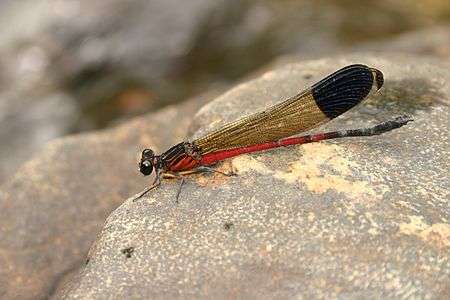Euphaea dispar
| Euphaea dispar | |
|---|---|
 | |
| Male | |
| Scientific classification | |
| Kingdom: | Animalia |
| Phylum: | Arthropoda |
| Class: | Insecta |
| Order: | Odonata |
| Suborder: | Zygoptera |
| Family: | Euphaeidae |
| Genus: | Euphaea |
| Species: | E. dispar |
| Binomial name | |
| Euphaea dispar (Rambur, 1842) | |
Euphaea dispar,[2][1] Nilgiri torrent dart,[3][4] is a species of damselfly in the family Euphaeidae.[1]
This species is endemic to the Western Ghats, known to occur only in north of the Palghat Gap; Dakshina Kannada, Udupi and Kodagu to the Nilgiris.[5][1]
They breed in streams flowing through evergreen forests. Usually the males are found perched on the twigs hanging some feet above the water, and often at a great height. The males of this species can be easily distinguished from other Euphaea species by the extent of black on apices of hind-wings, and by its turquoise-blue labrum and mandibles.[1][5][6][3][4]
See also
References
- 1 2 3 4 5 Kakkasery, F. (2011). "Euphaea dispar". IUCN Red List of Threatened Species. IUCN. 2011: e.T175155A7114592. Retrieved 2017-03-07.
- ↑ "World Odonata List". Slater Museum of Natural History. Retrieved 2017-03-07.
- 1 2 "Euphaea dispar Rambur, 1842". India Biodiversity Portal. Retrieved 2017-03-07.
- 1 2 "Euphaea dispar Rambur, 1842". Odonata of India, v. 1.00. Indian Foundation for Butterflies. Retrieved 2017-03-07.
- 1 2 C FC Lt. Fraser (1933). The Fauna of British India, including Ceylon and Burma, Odonata Vol. I. Red Lion Court, Fleet Street, London: Taylor and Francis.
- ↑ Subramanian, K. A. (2005). Dragonflies and Damselflies of Peninsular India - A Field Guide.
External links
![]()
![]()
This article is issued from
Wikipedia.
The text is licensed under Creative Commons - Attribution - Sharealike.
Additional terms may apply for the media files.
